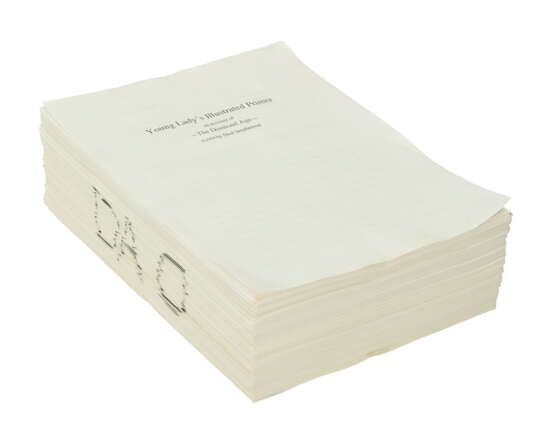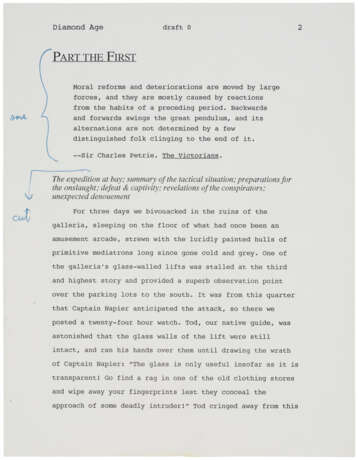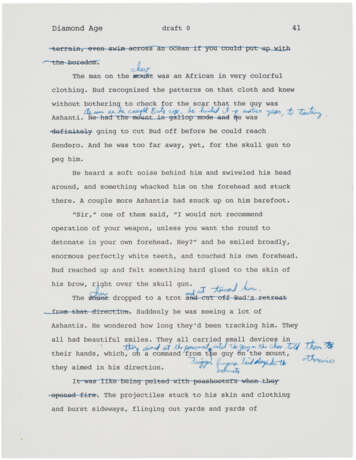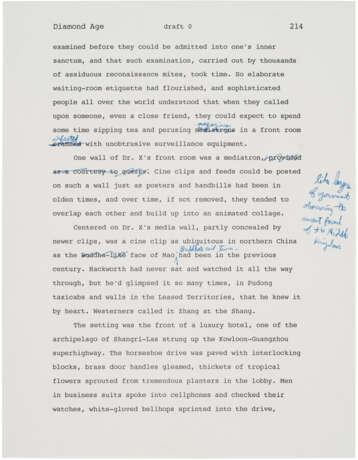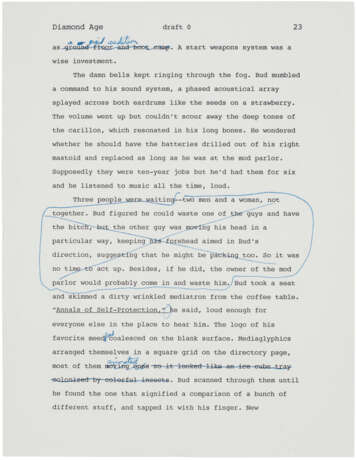ID 1353331
Lot 3 | The Diamond Age: original typed manuscript
Valeur estimée
£ 40 000 – 60 000
Neal Stephenson’s original typed manuscript for his visionary work The Diamond Age, annotated throughout by the author and with notes attributed by Stephenson to K. Eric Drexler, whose groundbreaking work on nanotechnology is central to the novel.
Winner of the Hugo and Locus Awards for Best Science Fiction Novel in 1996, The Diamond Age: Or, A Young Lady’s Illustrated Primer is a seminal work of modern science fiction. Building on the pioneering research of scientists such as Richard Feynman and K. Eric Drexler, the story is set in a future where nanotechnology is pervasive, influencing every aspect of life. The story follows Nell, a young girl from a disadvantaged background who discovers the ‘Young Lady’s Illustrated Primer’, an advanced interactive computer that ‘looked exactly like a book’ and was designed to educate and guide its reader towards a richer life. For its exploration of how artificial intelligence can impact social hierarchies, The Diamond Age has become a canonical work in the field of educational technology.
The idea came to me when I saw a mobile designed to hang above a crib, with cards that could be swapped out for more complex designs as the baby's visual system developed. I thought, why not create an educational book that would tell the same stories with increasing complexity as the child grew up? The genesis of this book was as simple as that. A little girl finds a magic book that changes her life.
Important not only for its imaginative and thought-provoking narrative but also for its foresight into the potential of nanotechnology, it has been cited as an influence by many in the tech industry, much like Stephenson’s earlier work, Snow Crash. In its early development, the Amazon Kindle was codenamed ‘Fiona’ after a character in the novel, and the book’s vision of a future shaped by advanced technology continues to resonate with readers and technologists alike. In its depiction of the ‘media net,’ an anonymous peer-to-peer communications system ‘designed from the ground up to provide privacy and security so that people could use it to transfer money’, Stephenson appears to anticipate a system of cryptocurrency in which ‘financial transactions could no longer be monitored by governments’.
The annotations and alterations throughout the manuscript are fascinating. Those in the author's hand demonstrate the sharpness of his editing knife by his willingness to dispense with sentences and whole paragraphs where necessary. The changes he makes are typically taken up faithfully in the published novel, but occasionally represent an intermediate phase before a final edit was made at a later date. For instance, where the typed manuscript reads 'the messages on the billboards chased them aggressively', Stephenson's handwritten correction recommends 'the messages on the billboards pursued them like wolves', before in the published text this becomes '...like starving wolves'. His marginal notes show the manuscript still at a formative stage, alive to corrections by the author but edging close to full maturity. The notes by renowned engineer K. Eric Drexler give an insight into the important process of collaboration which ensured the scientific plausibility of the novel. They offer a technical commentary to which Stephenson was evidently receptive, often leading him to alter whole passages. A comment on Stephenson's description of a shockwave, for instance - that it 'Wouldn't go far: most energy would be deposited locally' - sits beside a passage which consequently appears much revised in the published text.
| Lieu d'origine: | Etats-Unis |
|---|---|
| Catégorie maison de vente aux enchères: | Livres imprimés |
| Lieu d'origine: | Etats-Unis |
|---|---|
| Catégorie maison de vente aux enchères: | Livres imprimés |
| Adresse de l'enchère |
CHRISTIE'S 8 King Street, St. James's SW1Y 6QT London Royaume-Uni | |
|---|---|---|
| Aperçu |
| |
| Téléphone | +44 (0)20 7839 9060 | |
| Commission | see on Website | |
| Conditions d'utilisation | Conditions d'utilisation |
